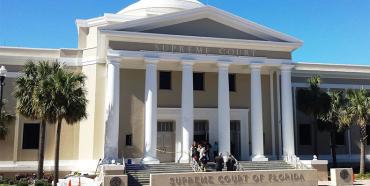By JOHN HAUGHEY THE CENTER SQUARE

Florida Supreme Court
Activist groups lobbying municipalities nationwide to file lawsuits against utilities as part of a two-decade climate litigation campaign have changed tactics and are now targeting energy manufacturers. That’s a shift posing significant repercussions for business, industry and consumers.
While “climate litigation” is now targeting “manufacturers in the energy sector” — oil and natural gas companies, refiners, fuel transport, coal gas producers, distribution, sales and retailers, including gas stations – ultimately, consumers will pay should a lawsuit be successful.
Among those most vulnerable: Florida’s 20,000 manufacturing companies that employ nearly 400,000 people, contribute $50 billion annually to the state’s economy and use one-third of the fossil fuels consumed in the Sunshine State.
According to the National Association of Manufacturers [NAM], which represents 14,000 companies that employ 12.8 million Americans, at least 14 municipalities, one state and a California crab fishermen’s association have filed cases against energy manufacturers “with more entities likely to file additional lawsuits” soon.
While no “climate litigation” lawsuits have been filed in Florida, EarthRights International [ERI], a Washington, D.C.-based nonprofit, met several times last October with Fort Lauderdale city officials and its city commission to convince the city to bring lawsuits against “manufacturers in the energy sector.”
Ultimately, the city opted not to do so, but according to NAM, similar efforts are being launched in Miami Beachand Jacksonville by activists using a Center for Climate Integrity report, “Climate Costs in 2040: Florida” — which states Florida taxpayers will need to pay $75.9 billion to build seawalls as sea levels rise — as a call to action against energy manufacturers.
The shift is documented in a report released this week by NAM’s Manufacturers’ Accountability Project [MAP] titled ‘Beyond the Courtroom: Climate Liability Litigation in the United States.
The report traces “climate litigation” over a 20-year span, identifies key players and “the multifaceted operation that continues to generate and support these lawsuits,” including “a new wave of lawsuits against energy manufacturers hitting America’s courtrooms since 2017” which pose “a dangerous risk to all of the country’s manufacturing sectors.”
MAP’s report — the first in a series — “explores how the climate litigation campaign has grown into a well-funded and well-organized group of nonprofits and law firms, many of which stand to benefit from protracted fundraising campaigns even if they ultimately lose the lawsuits. All the while, they try to leverage their ability to recruit plaintiffs to file these lawsuits in their effort to drive national energy policy and a potential settlement, even if their claims have no legal merit.”
After several states sued utilities seeking to impose penalties and restrictions on greenhouse gas emissions, in 2011 the United States Supreme Court – in an opinion written by Justice Ruth Bader Ginsburg – unanimously rejected “climate litigation” in its American Electric Power (AEP) v. Connecticut ruling.
The court determined Congress and federal agencies are “better equipped” than lawsuits and judges to address climate change.
In 2012, according to MAP, “environmentalists and lawyers convened in La Jolla, Calif., to come up with new ideas for suing the energy industry over climate change. The fundamentals of the litigation remain the same, but they have tried in several ways to distinguish these lawsuits” from the AEP lawsuit.
“For example, the plaintiffs sued energy manufacturers instead of utilities, filed their lawsuits under state [not federal] tort law, and told judges they were not trying to stop manufacturers from promoting, producing or selling their energy products. Instead, they claim these lawsuits are only about making energy companies pay for impacts of climate change.
“To date,” the report continues, “courts have found these are differences without legal distinctions, and that selling, just like using, energy does not make one liable for global climate change.”
At least three lawsuits against energy manufacturers have been dismissed by district courts the past few years, MAP’s report notes.
Despite a track record of failure, “why are environmentalists, local governments, and private law firms still investing time and resources into these lawsuits?” the report asks, referring to a previous statement – because many “stand to benefit from protracted fundraising campaigns even if they ultimately lose the lawsuits.”
Florida TaxWatch, the James Madison Institute and the Florida Justice Reform Institute are among Florida organizations that have issued warnings about “climate litigation.”
“For policies to succeed, public officials must work with business,” James Madison Institute Vice President For Policy Sal Nuzzo wrote in a widely-published op-ed. “A hostile approach toward manufacturers would ill serve our state and hinder efforts to address environmental issues. Holding a handful of companies financially liable for changes in global climate patterns is akin to compelling Florida residents to turn off their air conditioners after sunset. State and local officials would certainly not inflict such pain on Floridians knowing it will not make a dent in tackling climate change.”
John Haughey is the Florida contributor to The Center Square.








